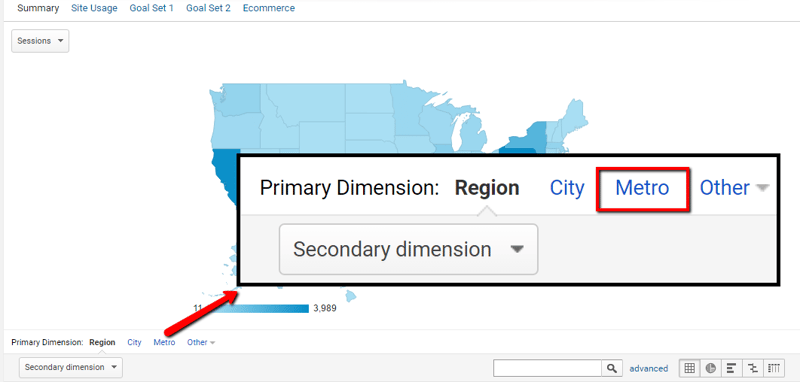Deep Study the 'Secondary Dimension' in Google Analytics: Everything You Must Comprehend
Deep Study the 'Secondary Dimension' in Google Analytics: Everything You Must Comprehend
Blog Article
Translating the Significance of Additional Dimension in Google Analytics: Everything About Its Relevance and Influence
In the world of digital analytics, the use of additional dimensions within Google Analytics offers as a crucial device for discerning much deeper layers of data understandings. The importance of additional measurements exists in their capacity to give a nuanced view of individual behavior and interaction with a site or platform.
Understanding Second Dimensions in Google Analytics
The understanding of secondary measurements in Google Analytics is crucial for acquiring much deeper insights right into user actions and site efficiency. While main dimensions provide basic data factors such as website traffic sources and web page views, additional measurements enable an extra nuanced analysis by giving extra context to these key metrics. By including secondary measurements, individuals can segment and filter their data to uncover patterns and fads that may not be right away evident.

Revealing the Conveniences of Secondary Dimensions
Building upon the fundamental understanding of second dimensions in Google Analytics, discovering the benefits they use exposes vital insights for improving information evaluation and decision-making. By integrating secondary dimensions, customers can delve deeper right into their data, acquiring an extra extensive sight of customer behavior, content performance, and other key metrics.
Furthermore, additional dimensions supply context to key information, supplying added layers of details that can aid in comprehending individual communications and choices. This improved understanding can guide strategic decision-making, bring about more targeted marketing campaigns, website optimizations, and overall enhanced performance. Fundamentally, secondary measurements act as an effective tool for unlocking deeper insights and making the most of the energy of Google Analytics for companies and site proprietors.
Leveraging Second Dimensions for Improved Insights
By using the power of second dimensions in Google Analytics, companies can discover deeper insights that drive educated critical and decision-making optimization initiatives. Leveraging secondary dimensions allows services to delve beyond surface-level data and get a much more detailed understanding of individual habits, audience demographics, web traffic resources, and website efficiency. By incorporating main measurements like website traffic sources with additional measurements such as geographic location or tool classification, services can recognize which devices or areas are driving the most useful traffic to their website.
Furthermore, secondary measurements enable organizations to sector and analyze data a lot more successfully, aiding them recognize trends, patterns, and opportunities that may have or else gone unnoticed. By using additional measurements, services can customize their marketing strategies, web content, and individual experience to better satisfy the needs and choices of their target audience. Fundamentally, leveraging secondary measurements in Google Analytics empowers companies to make data-driven choices that result in boosted performance, enhanced ROI, and sustainable growth.

Impact of Second Measurements on Data Evaluation
Enhancing information evaluation via the application of secondary dimensions in Google Analytics provides services with a much deeper understanding of their my latest blog post online performance metrics. By incorporating secondary dimensions, such as time of day, geographic place, or gadget group, companies can uncover important insights that may have been overlooked with primary dimensions alone. This boosted degree of granularity enables even more exact segmentation of data, making it possible for businesses to recognize patterns, trends, and site web correlations that can drive strategic decision-making.

Taking Full Advantage Of Prospective: Secondary Dimensions Methods
One essential approach is to combine second measurements with main measurements to get a thorough view of individual interactions. Coupling the main measurement of 'source/medium' with additional measurements like 'landing page' or 'tool category' can expose which networks are driving website traffic to specific pages or just how user actions varies across devices.
Moreover, utilizing secondary measurements to section information based on individual demographics, habits, or technology can aid organizations tailor their marketing initiatives to certain target market sectors. This targeted method can cause boosted conversion rates, improved individual experiences, and eventually, raised ROI. By maximizing the possibility of additional dimensions in Google Analytics, organizations can make enlightened choices, maximize their on-line visibility, and drive lasting development.
Conclusion
In verdict, secondary dimensions in Google Analytics play an important role in giving click for more info much deeper insights and boosting data analysis. Including additional measurements into data evaluation approaches can lead to more informed decision-making and boosted general efficiency.
While main measurements provide fundamental information factors such as traffic resources and page views, second dimensions enable for a more nuanced evaluation by supplying added context to these key metrics. By integrating key dimensions like traffic resources with additional measurements such as geographic place or tool category, organizations can determine which areas or gadgets are driving the most useful traffic to their web site.
By integrating second measurements, such as time of day, geographical location, or tool group, services can discover beneficial insights that may have been ignored with primary measurements alone. One crucial approach is to combine second measurements with main measurements to gain a thorough sight of user interactions. Coupling the key dimension of 'source/medium' with secondary dimensions like 'landing web page' or 'tool category' can disclose which channels are driving web traffic to certain web pages or just how customer habits varies across tools.
Report this page